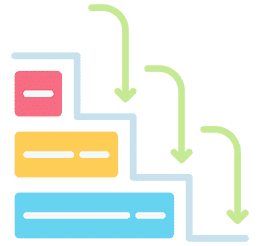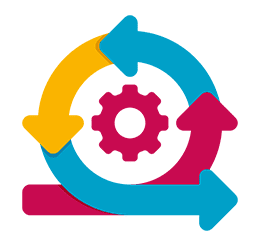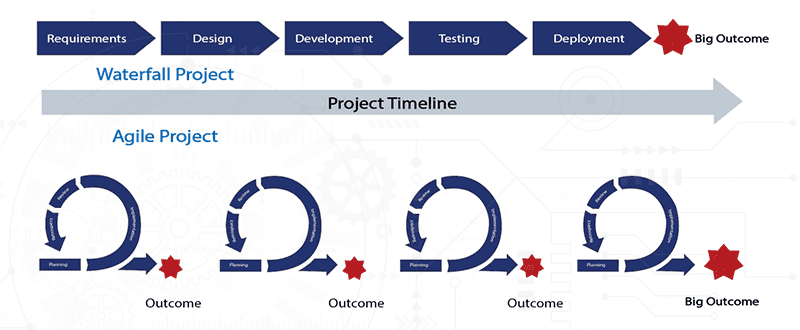When it comes to software development and implementation, two of the most commonly used methodologies are Agile and Waterfall. In this blog post, we will explore the differences between Agile and Waterfall and the reason why our company has chosen to adopt the Agile method not only for software development but also for its implementation.
For most new PIRO Fusion customers, the Waterfall method seems to come naturally for most people. There’s nothing wrong with that as we have used this method before, so this comes to everybody as the natural way of doing things. But Agile is the “new version” that aims to fix the weaknesses of the Waterfall method.
Since we are using Agile but some of our new customers are accustomed to the Waterfall method, it’s not difficult to draw a conclusion: the project will not go smoothly. So let’s go ahead and bring everyone on the same track.

Waterfall Approach
 The Waterfall approach is a term used to describe a traditional strategy in software development; one widely thought to be broken.
The Waterfall approach is a term used to describe a traditional strategy in software development; one widely thought to be broken.
The Waterfall approach to software implementation is a sequential and linear process that emphasizes planning, design, and execution. The Waterfall approach focuses a lot on designing the project in advance, which allows the team to carefully plan and define the requirements of the configuration before the implementation begins. This helps ensure that the software meets the customer's needs, and minimizes the risk of changes and modifications during the implementation phase.
Agile Approach
 The Agile approach to software implementation is a flexible and iterative process that emphasizes collaboration, adaptability, and continuous improvement. The Agile approach is based on the Agile Manifesto, a set of principles for software implementation that prioritizes the needs of the customer over rigid processes and schedules.
The Agile approach to software implementation is a flexible and iterative process that emphasizes collaboration, adaptability, and continuous improvement. The Agile approach is based on the Agile Manifesto, a set of principles for software implementation that prioritizes the needs of the customer over rigid processes and schedules.
One of the key benefits of the Agile approach is its flexibility. Agile projects are broken down into small, manageable chunks, which are called milestones. These milestones allow the project management team to continuously refine and improve the configuration as the project progresses. This helps ensure that the software meets the unique needs of the customer and that the project stays on track.
Another key benefit of the Agile approach is its focus on collaboration. Agile teams work closely with the customer to ensure that the software meets their needs, and receive feedback throughout the project. This helps ensure that the software meets the customer's expectations.

Why Our Company Uses the Agile Method
At PIRO, we believe that the Agile methodology is the best approach for software implementation. There are several reasons for this, including:
- Flexibility: the Agile approach allows us to be flexible and responsive to custom requests in the project requirements. Many of the companies we work with are small and medium-sized businesses that may not have a dedicated team to specify exact requirements at the start of the project. Often, while new users are still discovering the capabilities and possibilities of PIRO Fusion, new ideas break their way and the original project’s scope is extended. Using the Waterfall method would mean that requirements left out from the project scope at the start would not be included in the final configuration, as that method follows a rigid structure.
- Collaboration: the Agile approach emphasizes collaboration and communication between project managers, which helps ensure that everyone is aligned and each milestone is thoroughly understood, tested, and confirmed before moving forward.
- Cumulative outcomes: with Agile, project managers will experience smaller cumulative outcomes rather than a big outcome at the end. The level of detail at which the client's project manager understands the configuration will be much higher, as they will not just see the end result, but also understand each intermediate outcome.
- Continuous user testing and approval: since exact requirements (such as workflows, automations, product information, and attributes) are not always provided in advance, the Agile method enables us to focus on one module or milestone at a time and gather missing information from the client. After configuring a module, we always ask the customer to test the concept and approve that the configuration is working as expected. No configuration milestone should be closed without testing.
What are the risks of the Agile approach?
It is important for our customers to understand the Agile model, as they could unintentionally negatively impact their own project. This means that if they don't provide us with all the necessary information at the appropriate time, or if they skip continuous testing in favor of testing everything in the final phase, things could go wrong quickly. Going back to make changes to a module that has already been finalized and approved earlier could result in delays and increased costs.
In conclusion, the Agile methodology is the best approach for implementing PIRO as it allows us to be flexible, collaborative, and responsive to changing customer needs. However, it is essential for our customers to fully understand the methodology and participate in the process to ensure the project’s success.






